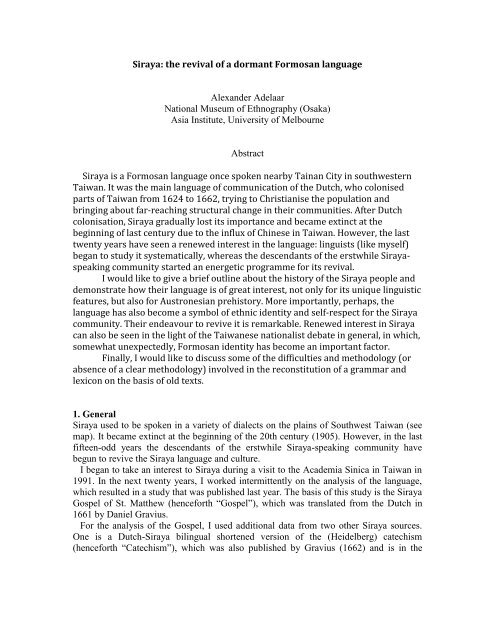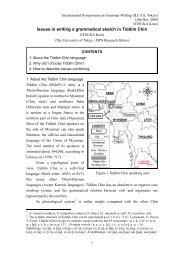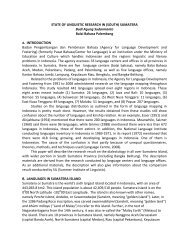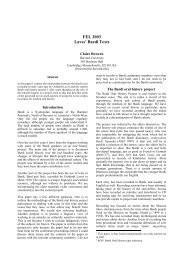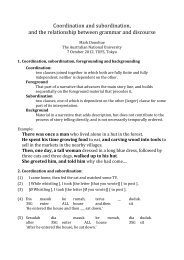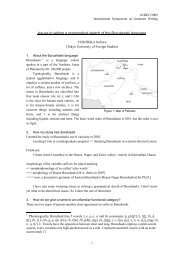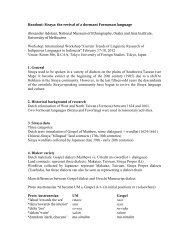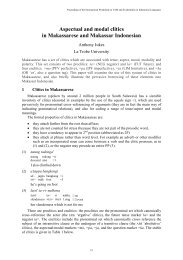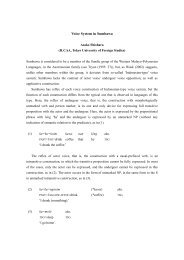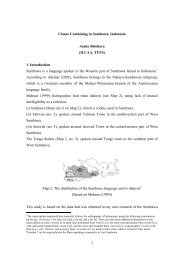Proceeding
Proceeding
Proceeding
You also want an ePaper? Increase the reach of your titles
YUMPU automatically turns print PDFs into web optimized ePapers that Google loves.
It is unclear to me whether the Gospel and UM dialects fit in with the dialect divisionsproposed by Ogawa, and if so, how exactly. 9One thing that seems clear, however, is that the Siraya speech area kept changing as aresult of demographic and political changes. While early Dutch sources point out that theSinkan dialect was ill understood south of Sinkan, the Dutch themselves used it as amedium of instruction in South and West Taiwan. After the Chinese took over the island,some Taivuan speakers moved further eastward into the mountains under the pressure ofincoming Chinese in the Tainan area. Some Taivuan speakers even crossed the centralmountain ridge and built new villages among the Amis people near Taitung on Taiwan‟seast coast (Tsuchida and Yamada 1991:2-3).4. Some observations about authorship and spellingDaniel Gravius is officially the sole author of the Siraya Gospel and Catechismtranslations, but his actual role needs further qualification. When he came to Taiwan(where he only stayed from 1647 to 1651), there had already been many attempts at Bibletranslations, dictionaries and teaching materials in the Sinkan dialect, including an earliertranslation of the Gospel of St. Matthew by Joannes Happartus (Ginsel 1931:99). In theIntroduction to his own Gospel translation, Gravius mentions that he had circulated thetext among fellow-missionaries in order to obtain the necessary feedback for an improvedfinal edition to which he had been commissioned (Campbell 1888:xiv-xv). Especially hisassistant Anthonius Hambrouck had been helpful in providing him with such feedback.As to the Catechism, this was based on a large corpus of questions and answers in Sirayaprepared previously by his colleagues Joannes Happartius and Simon van Breen.Gravius‟ contribution was to extract a shorter version and edit it for publication (Ginsel1931:98). This background information clearly shows that Gravius was not alone in hislinguistic endeavours. He received the help of others, and at least to some extent he musthave built on the foundations laid by his earlier colleagues.This is also reflected in the spelling in the Gospel, which shows the hand of severaleditors.There are of course several factors contributing to spelling inconsistencies in this text.Among others, they reflect the lack of spelling uniformity in 17 th -century Dutch itself,where there were two conflicting spelling traditions as well as a more general confusionabout spelling rules. A salient example is the spelling of -kua, which means 'to move' or'to be at', depending on the meaning of the prefix it combines with. In the beginning ofthe Gospel text, we often find it spelled as 'qua', but at the end of this text it is invariablyspelled as 'koua': this variation is little else than a reflection of the different attitudesvarious editors of the Gospel must have had about the spelling of their own language.Some of these editors were French oriented, and others were in more favour of a spellingbased on the inherent properties of Dutch. Another factor is that the spelling in theGospel is not based on a real phonemic analysis, sometimes trying to express allegroforms and other pronunciation idiosyncracies along with more diagnostic forms.However, there is also some method to the madness. While at first it seems that thespelling is inconsistent throughout the gospel text, a careful computer count reveals thatsome of the spelling principles used in the first 21 chapters of this text differ more or lessconsistently from those used in the seven chapters at the end. Such organized9 Li (2010:Introduction) tries to identify the UM dialect with Siraya Proper, and the Gospel dialect with Taivuan, butmore evidence of a critical nature is required to make the case.
inconsistency once again demonstrates that different editors must have interfered inindividual sections.5. Formosan languages: numbers of speakers and vitalityAlthough most Taiwanese are nowadays of Chinese descent, historically the islandbelongs to the Austronesian-speaking world. Its indigenous languages are allAustronesian and are linguistically known as the “Formosan” languages. This term isderived from (Ilha) Formosa (“beautiful [island]”), originally a Portuguese name for theisland, by which it also became known in other European languages. In the seventeenthcentury there were at least 25 Formosan languages. Today, ten of these have becomeextinct, 10 and at least five others are on the verge of extinction. 11 Formosan languagesthat are not under immediate threat of extinction are those spoken by the Amis (177,000),Atayal (81,000), Bunun (50,000), Paiwan (68,000), Truku (24,000), Puyuma (11,000),Rukai (11,600), Saisyiat (5,300), Tsou (6,500) and Yami (3,500). 12It is clear that the vitality of these languages cannot be read from the numbers of theirspeakers alone. For instance, speakers of Truku are all above 20 years of age, and there isno younger generation to continue speaking the language (Tsukida 2005:291). A similarsituation exists with regard to Puyuma, which has hardly any speakers under 40 years ofage (Cauquelin 2004:322), and with regard to many other Formosan languages with largespeech communities. Such a generation gap is more alarming for the chances of survivalof a language than are low speaker numbers.There are more than 490,000 Aboriginal Taiwanese. 13 They make up slightly morethan 2% of the total population of 23,142,460 million, 14 the majority of which consists ofHoklo Chinese (70%); other large groups are Hakka Chinese (12-15%), and Chinesefrom various parts of the Chinese mainland, who migrated to Taiwan along with theKuomintang regime in 1949, as well as their offspring (12-15%; Saillard 2004:362fn.3).6. The linguistic classification of Formosan languagesThere are more than 1,200 languages belonging to the Austronesian language family,which has several primary branches. The number of these primary branches remains amatter of debate, with estimates varying between four and ten (see below). However,historical linguists generally agree that the Formosan languages of Taiwan representseveral primary branches of Austronesian, whereas Austronesian languages outsideTaiwan all belong to one single branch, called „Malayo-Polynesian‟. 15 The latter are thenative languages of large parts of insular Southeast Asia and the Pacific as well as of theisland of Madagascar.The fact that Taiwan alone is home to all but one of the primary branches ofAustronesian make the Formosan languages of particular interest to historical linguists:because of their genetic diversity, these 25 languages theoretically encode much moreinformation about the ancestral Proto-Austronesian stock language than all other 120010 To wit Babuza, Basay, Favorlang, Hoanya, Ketangalan, Kulon, Qauqaut, Papora, Siraya, and Taokas (Zeitoun2004:41).11 To wit Kavalan, Kanakanavu, Pazih, Saaroa, and Thao (Zeitoun 2004:41); numbers of speakers of these languagesrun from several hundred (Saaroa, Kanakanavu), to less than fifteen (Thao, Pazih).12 Council of Indigenous Peoples 2008 (http://www.apc.gov.tw/main/index_en.jsp). Note that these are populationfigures and do not indicate how many speakers each ethnic group language has. Note also that Yami isclassificatorily a Malayo-Polynesian (extra-Formosan) language (see fn.21).13 Council of Indigenous Peoples 2008 (http://www.apc.gov.tw/main/index_en.jsp).14 July 2010 figures, National Statistics, Republic of China (Taiwan).15 One apparent exception is Yami, which spoken in the Republic of Taiwan but belongs to the Malayo-Polynesianbranch; however, this language is actually not spoken on Taiwan itself but on Lanyu (Botel Tobago), a small islandoff Taiwan‟s southeast coast.
Austronesian languages together. It correlates with the fact that Taiwan is of greatarchaeological value as a stepping stone for the spread of Austronesian speakers, whocame from the South Chinese mainland and migrated to Southeast Asia and the Pacificsome 6,000 years ago.Proto AustronesianNine Formosan branches(representing ca. 25 indigenouslanguages of Taiwan, including Siraya)Malayo Polynesian(representing the more than one thousand Austronesian languagesin Southeast Asia, the Pacific, and Madagascar)Fig. 1 : primary branches of the Austronesian language family tree according to Blust (2009:29-30).The number of primary branches in the Austronesian language tree has often been setat four, after Ferrell‟S (1969) distinction of an Atayalic branch (consisting of Atayal andSeediq), a Tsouic branch (Tsou, Kanakanavu and Saaroa), a Paiwanic branch (containingPaiwan and all other Formosan languages), and a Malayo-Polynesian branch. It has,however, become increasingly clear that this classification is not accurate, primarilybecause of the heterogeneity of the Paiwanic branch. Several other classifications havebeen proposed. The historical linguist Robert Blust (2009:29-30) distinguishes tenbranches. Siraya belongs to Blust‟s East Formosan branch, together with the Basai-Trobiawan, Kavalan and Amis languages.7. Aboriginal Taiwan and Austronesian prehistoryAs indicated above, the linguistic data show that the genetic variety in Taiwan is muchgreater than anywhere else in the Austronesian language area. They also show that by andlarge the Formosan languages are phonologically more conservative and complex thanthe Malayo-Polynesian languages 16 . Both these factors indicate that Austronesianspeakers must have migrated from Taiwan to the various regions where Austronesianlanguages are spoken today, rather than that they came to Taiwan from any of the otherAustronesian regions.While the linguistic evidence refutes a „southern origin‟ of Formosan speakers, it isnot able to trace Austronesian languages back to the Asian mainland 17 . There are16 Phonetic probability and a series of unconditioned mergers of various Austronesian phonemes into one singlephoneme in Malayo-Polynesian languages strongly suggest that this is the case.17 Nor is it able to tell whether or not there was a population on Taiwan prior to the Austronesians.
Chenggong in 1661, they had managed to baptise a large number of the Formosans undertheir control. However, many converts were only nominal Christians, and after the defeatof the Dutch, Zheng Chenggong succeeded in eradicating the new religion. As has oftenbeen pointed out in the literature, literacy outlived religion as far as Dutch heritage inTaiwan was concerned: in the early 19 th century some Siraya were still able to write theirlanguage in Roman script.10. The Austronesian ethnic groups in the Taiwanese nationalist debateFor most of last century, the Austronesian ethnic groups played a very subordinate role inthe political life of their island, and they were often exposed to severe economic, socialand cultural oppression. However, this has begun to change in the last two decades or so.The following account is based on Stainton (1999). Somewhat simultaneously with thepolitical liberalisation of Taiwan and the rise of Taiwanese nationalism in the 1980s, theAustronesian ethnic groups underwent an awareness process and strove for recognition oftheir cultures and their ethnic rights as the nation‟s earliest inhabitants. In 1984, theyformed the Alliance of Taiwanese Aborigines. The Taiwanese nationalists, seeking todifferentiate themselves from the Chinese nationalism of the Kuomintang and, later, thePRC mainland, soon began to capitalise on the unique position of the Austronesiangroups. Their historical arguments for an independent Taiwan were based, among otherconsiderations, on the fact that Taiwan originally did not belong to what was traditionallyconsidered the Chinese polity (i.e. during the Ming dynasty and before), and that theannexation of Taiwan to China had been a relatively short one (it had lasted for hardlymore than two centuries). The presence of an older non-Chinese population clearlyunderscored that Taiwan was different. Furthermore, some Austronesian groups hadtraditional beliefs claiming that their ancestors came from the south (and not from theAsian mainland), which in the view of some nationalists added weight to the originalotherness of Taiwan. The most recent evidence adduced in support of the Taiwannationalist cause is based on gene tests, which show that the Austronesian groups sharepart of their genes with the Hoklo majority. This line of argument would mean that themajority of pre-Kuomintang Chinese in Taiwan are of Austronesian ancestry, a point infavour of the otherness of Taiwan as a whole vis-à-vis mainland China.However, supporters of the annexation of Taiwan by the People‟s Republic of Chinahave also managed to use the case of the Austronesian inhabitants of Taiwan for theirown cause. They consider Taiwan a province of China; it came under Chineseadministration in the late 17 th century – gaining provincial status in the 1880s – and themajority of the population is culturally and linguistically Chinese. They find historicaljustification for their case in the fact that, in the past, Taiwan was geologically still part ofthe mainland. Furthermore, according to recent archaeological evidence, the Austronesianinhabitants originally came from the South Chinese mainland. Some supporters of theannexation are keen to point out some cultural similarities between the Austronesians inTaiwan and some of the minority groups in mainland China.Meanwhile, the Austronesian ethnic rights activists in Taiwan are emphasising the factthat they were the first inhabitants of the island. Some of them take pride in the fact thatTaiwan is the prehistoric homeland of the Austronesian languages, which nowadays arespoken almost everywhere Southeast Asia, the Pacific and Madagascar. They also seeksome differentiation from Hoklo-dominated Taiwanese nationalism.There is no need to point out the ad hoc nature of most of the historic arguments usedin the above discussion, and their irrelevance to linguistic analysis. As some of thesearguments are based on linguistics and archaeology, however, it is pertinent to reiteratebriefly the current position of linguists and archaeologists on the prehistory of Taiwan.Their evidence suggests that this island was the homeland of Proto Austronesian or, atleast, the place from where its speakers 6,000 years ago began to spread over SoutheastAsia, the Pacific and Madagascar. Before they came to Taiwan, these early Austronesians
must have come from the South Chinese mainland, where some 8,000-year-oldAustronesian archaeological sites have been found. The linguistic and archaeologicalevidence clearly refutes a „southern origin‟. From this it may seem as if these disciplinesfavour the pro-annexation position, but this is not really the case. While Bellwood(1977:205) and Blust (1999:70-73) believe that the ancestors of the Austronesians some8,000 years ago lived on what is currently the South Chinese mainland, both work on theobvious assumption that at that stage Chinese cultural and political domination had notyet extended that far South.11. A probable cause of the extinction of SirayaOne may wonder why an apparently important community like the Siraya lost itslanguage, whereas many other, much smaller and politically less prominent groups havebeen able to maintain theirs. According to Professor Paul Jen-kuei Li, the reason must bethe extent to which the Siraya were exposed to Chinese (Hokkien) language and culture.Southwest Taiwan is not mountainous, and it is much more accessible to overseas settlersthan most central and eastern parts of Taiwan, where life was no doubt harder, but whereAustronesian communities were also much more out of reach of Chinese influence. 21 Thefact that the Siraya belong to the southwestern plains, which are much more populatedand urbanised than many other parts of Taiwan, and the fact that they interacted morewith the Chinese than many other Aboriginal groups did, are the probable causes of theirfar-going sinicisation and the loss of their language. 2212. Attempts at reviving SirayaThe Taiwanese government acknowledges the existence of distinct ethnic groups amongthe Aboriginal population. Some twelve groups have a separate ethnic status, and variousother groups are applying for this. An important condition is to have one‟s own language.In practice, this is not as straightforward as it sounds, because in some cases the speech ofan aspiring group is considered a dialect of the language of another group that has alreadyobtained separate status. In other cases, the language of a group may have lost itsimportance as a cultural emblem because it has become extinct or is on the verge ofextinction (Saillard 2004:362-363).The Siraya recently applied for separate ethnic status but were unsuccessful. Ofcourse, there is no denial that they are now all speakers of Hokkien Chinese and have notused their original language for more than a century. Nevertheless, Siraya still exists as arelatively well documented extinct language.An organisation called the Tainan Ping-pu Siraya Culture Association has for sometime been striving for the maintenance of the Siraya cultural heritage, including therevival of the Siraya language. Edgar Macapili, one of the members of the association,has been trying for some years to instil enthusiasm for this language into the Sirayacommunity. In 2002, he wrote a trilingual (Hokkien, English and Siraya) biblical play(Macapili 2002). It was performed in Tainan just before Christmas. The actors wereSiraya children of all ages. The event obtained much publicity and media coverage. Theassociation was evidently spurred on by the success of another ethnic group, the Kavalan,in obtaining separate ethnic status earlier in the year. (The Kavalan language is on theverge of extinction).Some who attended the event expressed their doubts at the possibility of reviving adead language, especially one that has been almost forgotten for such a long time. Similar21 This incidentally demonstrates a claim often made in language endangerment studies. A language is not onlyendangered by the small size of its speech community, but also (and possibly even more so) by the regular andintensive exposure of its speech community to another more prestigious language.22 Prof. PAUL JEN-KUEI LI, personal communication.
doubts were shared by some linguists and other scholars. The author of the play hadconstructed Siraya sentences from individual words and fairly transparent grammaticalelements in the gospel text. The result does not always follow the actual grammaticalrules of the Gospel, which is to be expected given the lack of descriptive data available tothe author. However, in terms of language revival the project was remarkably successful.Macapili and his Association are currently preparing a trilingual Siraya textbook withCDs (Macapili in press).Another outstanding attempt to give the Siraya community some of its linguisticheritage back were studies mentioned above by Bien-horn Chen, a native-born Siraya.13. Reconstituting a language from texts: Methodology?What methodology should be applied in resurrecting a language from written data?It is hard to give a clear answer to this question. There is no ready-mademethodology, and the only guidelines I can think of right away are as follows:• keep staring at the material;• re-read everything a thousand times: every time you think of something new, youwill have to go through the data to check if it holds water;• keep an eye on variation and try to interpret it: the exercise is just as muchphilological (old-fashioned text interpretation) as it is linguistic.While I worked on the Siraya material, I realised that there were a number ofimportant complications involved. First, the data represent several dialects.Furthermore, there is a considerable variation in spelling: this is partly due to theuncertainty about how to spell Siraya words, and partly to the fact that two spellingtraditions are reflected in the data. Another factor is that the spelling rules are notbased on clear phonemic insights, as they were designed halfway the 17th century;some of the spelling rules are Dutch rules and are more appropriate to the structureof Dutch than to that of Siraya. This partly unstructured spelling variation is madeworse by the fact that the Siraya data were written down by non-native speakers.These data are therefore based on the insights of these non-native speakers, andthey are not necessarily an accurate reflection of the structure of Siraya itself. As aresult of all this, there are some misleading errors in the data.It may sound banal but it has to be spelled out: one does not know these things atthe beginning of one's analysis of the data. And since there is no methodology tellingyou how to analyse the unexpected, maybe the only methodological advice here is toexpect such complicating factors. (Note that bilingualism is not a rare occurrence inold texts and inscriptions).One clear methodological difference between working with a corpus and doingfieldwork with native speakers is that there is no need to go beyond the data in frontof you: that gives a certain clarity and reassurance to your work. However, there isalso no way to check anything beyond these data, so that you may end up with manyloose ends no matter how comprehensive and thorough you make your analysis.
Among the strategies to get a better grip on the data are reading grammars fromclosely related languages, and reading about more general linguistic topics involvingthe language family to which the language in question belongs. This of courseincludes comparative-historical linguistics about the language in question. In thecase of Siraya, many of its features also occur in other Formosan languages, andreading into the Formosan literature was the best way to get prepared for thestrange features one comes across of Siraya. A problem was that when I began tostudy Siraya, the state of the art of Formosan studies was much less sophisticatedthan it is today.Another strategy is to concentrate on phonotactics. In order to do thatefficiently, all textual material should be typed into a computer file.(Note however that while phonotactics has to do with phonemes, what one has infront of oneself are letters, which is in fact an extra distorting interface that must betaken into account). Phonotactic questions are: What sounds and soundcombinations do occur? What positions do consonants and consonant combinationstake (do they occur word-initially, between vowels, in consonant clusters, wordfinally)?What positions and syllables do vowels take (immediately at the beginningof a word, at the end of a word, in last, penultimate or antepenultimate syllables)? Ifvowel length is distinctive, how are long and short vowels distributed? To studyphonotactics properly, one is often tempted to go by impressions, and these lead topremature conclusions. In order to avoid that you will have to count what you find:use the search button or another device on your computer to make sure you do notmiss anything, and then compare the figures to see if they are significant. Importantis that while certain features may be more frequent than others, they may occur in afew words only and not in the bulk of vocabulary: in other words, make sure todistinguish between types (different words/constructions exhibiting a certainfeature) and tokens (the sheer number of occurrences of that feature in whateverword/construction).One should also check if consonants are morphologically conditioned. Forinstance, in Siraya, both b and v occur, but most b's alternate with v in general oroccur instead of v after certain prefixes or in the prefixed copied first syllable in caseof reduplication. For example, vana-vana 'to tell, report' alternates with bana-vana;when undergoing reduplication, vare 'wind' becomes ba-vare 'to blow (of a storm)';compare ma-vulas 'to be sad' and käwx-bulas 'to become sad'. (Note however thatwhile almost all b's alternate with v, most v's do not alternate with b.)One should be alert that there may be hidden phonemes; at the same time,one should also eliminate letters/letter combinations indicating distinctions that arenon-phonemic.A good example of a phoneme that is not indicated but nevertheless exists isSiraya schwa. Its presence can be deduced from a combination of unusualconsonants clusters, e.g.:tbung 'spouse' --> t[ə]bung cf. PAn *Cəbung 'to meet'matmoei 'full' --> ma-t[ə]muy cf. PAn *təmuy 'many; full'pchag 'pounded rice' --> p[ə]xax cf. PAn *bəRas id.rbo 'inside' --> r[ə]bo cf. PAN *ləbu id.
It can also be gleaned from the variation between short i and short u in certainwords, e.g.voukugh, voukig 'hair of head' --> vukəx cf. PAn *bukəS/buSək id.ninim, nnum 'six' --> nəm, nə-nəm cf. PAn *ənəm, *nəm id.talum, talim 'to plant' --> taləm cf. PAn *taNəm (*taɫəm) id.'tdarim, 'td-darum 'to go down' --> taw-darem cf. PAn *daləm id.Finally, it also appears from the many suffixes with a -Vn pattern. Of the latter, most-an suffixes reflect the PAn suffix *-an; however, -in, -un, and -'n have unstablevowels and alternate with one another, whereas the derivations in which they occuroften agree are often patient-oriented and thus corresponding to PAn patient suffix*-ən. Compare the following two derivations:kannin 'to be eaten' --> kan-ən, versus:pa-kan-nun 'to be fed' --> pa-kan-ənCompare also :æillingigh-'noumi 'heard by you' -->ä-illingix-[ə]n-umi(Reduplication-hear-Patient.Suffix-2pl.AGAn example of many letters and letter combinations referring to only a fewphonemes are hg/g/gh, h, Ø (occurring in the Gospel ) and g/ch (occurring in theUM). I interpret hg/g/gh and ch as one unitary phoneme x; I also interpret h and øas velar fricatives wherever they occur in free variation with hg/g/gh/ch.Examples:hæuugh (xxiii:26), hæuuh (xxvi:42) ‘mug’häuxsivægh (xiii:29), sivæh (xiii:30) ’wheat’siväxrÿgh (xxiii:13), rÿh (xi:29) ‘neck; mind’rĭxpapæmæmæh-en (xi:22), papæmæmæ-en (v:21),pa-pä-mämäx-ǝn,papæ-mæmæghan (xxvii:27) ‘court of justice’pa-pä-mämäx-antallag, tallah, tallagh, tallach ‘house’tălaxpihgik (v:23) ‘altar’,pixikTama-p’hik, Tama-phik, Tama-p’higik, Tama P’hgik ‘priest’ Tama-p’xik, TamapixikMany words in the Gospel dialect have clusters consisting of h followed by anotherconsonant. These clusters occur in underived words as well as in derivations.However, at close inspection it appears that this h is much more often presentbefore intervocalic voiceless stops than before any other consonant. The consonantspreceded by h are k (240 instances), p (103), t (216), q (6), b (4), d (4), f (1), l (1), s(1). It also appears that there are hardly any cases of intervocalic voiceless stopsthat are not preceded by h, and that the few cases where h appears before a
consonant other than a voiceless stop, it can be explained morphologically orhistorically. I conclude that h before intervocalic voiceless stops indicated a sort ofnon-phonemic glottal friction, which could be heard before intervocalic voicelessstops in the gospel dialect of Siraya (but not in the UM dialect). It is thereforeorthographically not relevant, and I leave it out in my spelling. Examples:vahto (25x) ‘stone’rahpal (11x) ‘foot’tahkout (xvii:6) ‘fear’pouliliht-au (vi:28) (pay.attention+SJ.UO) ‘observe!’myhkakoua (7x), myhkaqua (2x) (AO-LOC-RDP-be.at) ‘eternal’vatorapaltakutpulilit-awm-i-ka-kuaFinally, I consider all remaining instances of h as representing a phonemic h, that is,all instances that stand for neither x, nor for non-phonemic glottal friction beforeintervocalic voiceless stops or at the end of subjunctive markers and pronouns(where they are also non-phonemic). These remaining instances occur wordinitially,intervocalically and in clusters after a voiceless occlusive. They do notoccur word-finally. Examples:houka (vii:3) ‘mote, splinter’kahouvaran (xiii:12) ‘abundance’mavahier (v:44) ‘to hate’pa’-phud-den, in vahto ki pa’-phud-den (xviii:6) „millstone‟than (xxvi:9) ‘profit’thabul (ii:20) ‘to travel’khyt (ix:16) ‘rent’hukaka-huvar-anma-vahiervato ki pa-phŭd-ǝnthanthabŭlkhĭtOnce all the letter are checked for the positions they take, the combinationsin which they occur, and the various sounds that they represent, one can try toderive a phonemic system. Whereas some phonemic relations will be easy todemonstrate, some other ones may remain unclear. This is because not all hiddenphonemes will necessarily become apparent. In the case of schwa, it appears thatthe original recorders did not diagnose it as a separate phoneme but their unstablenotation of it is still a give-away that there was one. In some other cases, however, aphoneme distinction may simply have been lost: given the many uvular and velardistinctions usually made in Formosan languages, it is quite conceivable that someof these dictinctions were never noticed for Siraya. In other cases again, a certainletter combination stands for a phoneme (or phoneme combination) the nature ofwhich cannot be established. This is the case of nḡ, which occurs in root-initialposition in words such as ma-nḡala 'to be ashamed'; nḡale 'anger, wrath'; m-u-nḡara(ii:7) to hear out, get information from out'; nḡara 'bush'; nḡataf' gate, door'. I diagnose itas a phonemic element nḡ but have no way to find out how it was realised and whether itwas one phoneme or two.In making a grammatical analysis, the result will always be limited by thewritten nature of the data. Certain modal distinctions such as subjunctive orimperative mood are normally not expressed, except in occasional quotations. The
same applies to vocatives and terms of address. Stress and certain sandhiphenomena will also not always surface in written texts.In the case of Siraya, the fact that it is essentially translationese is anotherimportant factor preventing us from getting to know the natural language Sirayaonce was. On the basis of evidence found in the material alone, one gets theimpression that the prefix ni- was a past tense marker, as it is used in the Gospel textin the same place where 17th century Biblical Dutch expresses past tense. However,that may be due to the Dutch background of the translators, and the likelihood thatthey did not have a good grasp of the distinction between past tense and perfectiveaspect. The chance that Siraya ni- was actually a marker of perfective aspect (ratherthan a past tense marker) is real in light of the meanings its cognate prefixes have inother Formosan languages. The same goes for the anaforic and cataforic use of thedemonstrative pronouns ăta 'this' and ăna 'that'. They do frequently expressanaforic and cataforic reference in the Gospel, but they tend to do so in the sameplaces as where Dutch demonstrative pronouns express anaforic and cataforicreference. In summary, while formally the grammatical elements may be extant,there is little doubt that their semantic values will often be compromised.
Reference listAdelaar, Alexander, 1994, „Malay and Javanese loanwords in Malagasy, Tagalog andSiraya (Formosa)‟, Bijdragen tot de Taal-, Land- en Volkenkunde 150/1:49-64.Adelaar, Alexander, 1997, „Grammar notes on Siraya, an extinct Formosan language‟,Oceanic Linguistics, 36/2:362–397.Adelaar, Alexander, 1999, „Retrieving Siraya Phonology: a New Spelling for a DeadLanguage‟, In: Zeitoun, Elizabeth and Li, Paul Jen-kuei (eds), Selected papersfrom the Eighth International Conference on Austronesian Linguistics. Taipei:Academia Sinica. p. 313–354.Adelaar, Alexander, 2000, „Siraya Reduplication‟, Oceanic Linguistics, 39/1, p. 33–52.Adelaar, Alexander, 2004, „The Coming and Going of Lexical Prefixes in Siraya’,Language and Linguistics (Taipei), 5/2, p. 333–361.Adelaar, Alexander, 2004, „Le siraya: interprétation de données du 17e siècle,‟ InZeitoun, Elizabeth (ed.), Les langues austronésiennes [Austronesian languages].Paris: Ophrys. (Faites de Langues Vol. 23.), p. 269–288.Adelaar, Alexander, 2006, „Siraya dialogues‟, in Streams converging into an Ocean.Festschrift in honor of Professor Jen-kuei Li on his 70th birthday (Henry Y.Chang, Lillian M. Huang, and Dah-an Ho eds). Taipei: Academia Sinica; 665-85.Adelaar, Alexander, 2007, „Siraya, Taiwan‟s oldest written language‟, in: The Marginsof Becoming. Identity and Culture in Taiwan. (C. Storm and M. Harrison eds).19-34. Wiesbaden: Harrassowitz.Bellwood, Peter, 1997, Prehistory of the Indo-Malaysian Archipelago. (revised edition).Honolulu: University of Hawai‟i Press.Bien-Horn, Chen, 2001, Notes on Vocabulary of Siraya Version of Matthew. (no place):Taiwan Plain Indigenous Peoples Association.Blussé, Leonard, Everts, Natalie and Frech, Evelien, 1999, The Formosan Encounter.Notes on Formosa’s Aboriginal Society: a Selection of Documents from DutchArchival Sources. Volume I: 1623–1635. Taipei: Shung Ye Museum of FormosanAboriginesBlussé, Leonard, Everts, Natalie and Frech, Evelien, 2000, The Formosan Encounter.Notes on Formosa’s Aboriginal Society: a Selection of Documents from DutchArchival Sources. Volume I: 1636–1645. Taipei: Shung Ye Museum of FormosanAborigines.Blust, Robert A., 1995, The Position of the Formosan Languages: Methods and Theory inAustronesian Comparative Linguistics.“ In Li, Paul Jen-kuei, Tsang, Cheng-hwa,Huang, Ying-kuei, Ho, Dah-an and Tseng, Chiu-yu (eds), Austronesian StudiesRelating to Taiwan. Taipei: Academia Sinica (Symposium Series of the Instituteof History and Philology, Number 3), p. 585–650.Blust, Robert A., 1999, Subgrouping, Circularity and Extinction: Some Issues inAustronesian Comparative Linguistics.“ In: Zeitoun, Elizabeth and Li, Paul Jenkuei(eds), Selected Papers from the Eighth International Conference onAustronesian Linguistics. Taipei: Academia Sinica 1999. (Symposium Series ofthe Institute of Linguistics No. 1), p. 31–94.Blust, Robert A., (online), Austronesian comparative dictionary.http://www.trussel2.com/ACD/acd-bib.htm.Campbell, William, 1888, The Gospel of St. Matthew in Formosan (Sinkang dialect).London: Trübner & Co.
Campbell, William, 1903, Formosa under the Dutch. London.Candidius, Georgius, 1628, Discourse. Family Archive Huydecoper R.67–68. Utrecht:Rijksarchief (reprinted and provided with a translation in Blussé et al. 1999).Caron, W.H.J., 1972, Klank en teken. Verzamelde taalkundige studies.Groningen: Wolters-Noordhoff.Cauquelin, Josiane, 1991, The Puyuma language. Bijdragen tot de Taal-, Land- enVolkenkunde 147: 17–60.Cauquelin, Josiane, 2004, „Étude linguistique d‟un chant rituel, penaspas, (puyuma– Taïwan)‟, In Zeitoun, Elizabeth (ed.), Les langues austronésiennes[Austronesian languages]. Paris: Ophrys. (Faites de Langues Vol. 23.), p. 321–331.Council of Indigenous Peoples 2008(http://www.apc.gov.tw/main/index_en.jsp).Ferrell, Raleigh, 1982, Paiwan dictionary. Pacific Linguistics Series C73. Canberra:Research School of Pacific Studies, Dept. of Linguistics, Australian NationalUniversityGinsel, Willy Abraham, 1931, De Gereformeerde Kerk op Formosa of de lotgevalleneener handelskerk onder de Oost-Indische-Compagnie 1627-1662. Ph.D fromLeiden University.Gravius, Daniel, 1661, Het heylige Euangelium Matthei en Johannis. Ofte Hagnau kad'llig matiktik ka na sasoulat ti Mattheus ti Johannes appa. Amsterdam: MichielHartoghGravius, Daniel, 1662, Patar ki tna-'msing-an ki Christang ofte 't Formulier desChristendoms. Amsterdam: Michiel HartoghHappart, Gilbertus, 1650, Woordboek der Favorlangse taal, waarin het Favorlangsvoor, het Duits achter gestelt is. (Re-published in Batavia and provided withan Introduction by W.R. van Hoëvell in 1842).Li, Paul Jen-kuei, 2010, Studies of Sinkang manuscripts. Languages and LinguisticsMonograph Series 39. Taipei: Institute of Linguistics. Academia Sinica.Macapili, Edgar, 2002, Ta avang ki Noe-an. Noah’s Ark in Siraya. Tainan (A newerversion is about to appear under the title Na avang ti Noe ki Su ka Maka-Siraya).Macapili, Edgar (to appear) Sulat ki Su ka Maka-Siraya ki kakuting-an (Siraya LanguageLearning Book, a bilingual English and Chinese manual).Murakami, Naojirô, 1933, Sinkan Manuscripts. Memoirs of the Faculty of Literature andPolitics, Taihoku Imperial University, Vol.2, No.1. Formosa: Taihoku ImperialUniversity.Nojima, Motoyasu, 1996, Lexical prefixes of Bunun verbs, Journal of the LinguisticJournal of Japan 110:1-27.Ogawa, Naoyoshi, 1905, „Part of a manuscript of the Formosan native languages‟, in:Taiwan Kyoikukai Zasshi [Journal of Education in Taiwan] 39 :17-20 [inJapanese].Ogawa, Naoyoshi, 2006, A comparative vocabulary of Formosan languages and dialects,edited by Paul Jen-kuei Li and Masayuki Toyoshima. Asian-African LexiconSeries No.49. Tokyo : Tokyo University of Foreign Studies, Research Institute forLanguages and Cultures of Asia and Africa.Saillard, Claire, 2004, „Les langues austronésiennes de Taïwan: peuvent-elles échapper àla minoration? [Austronesian languages in Taiwan: can they avoid being
undervalued?]“ In: E. Zeitoun (ed.), Les Langues Austronésiennes [Austronesianlanguages]. Paris: Ophrys. (Faits de Langues Vol. 23), pp. 361-378.Shepherd, John Robert, 1995a, Statecraft and Political Economy on the Taiwan Frontier1600-1800. Taipei: SMC Publishing Inc (2nd ed.; 1st ed. 1993 by Stanford UP).Shepherd, John Robert, 1995b, Marriage and Mandatory Abortion Among the 17th-Century Siraya. Arlington, VA: American Anthropological Association.(American Ethnological Society Monograph Series, Number 6).Stainton, Michael, 1999, „The Politics of Taiwan Aboriginal Origins.“ In: Rubinstein,Murray A. (ed.), Taiwan. A New History. Armonk (NY): Sharpe, p. 27–45.Tsuchida, Shigeru. 1976. Reconstruction of Proto-Tsouic phonology. Study of Languagesand Cultures of Asia and Africa Monograph Series No.5. TokyoTsuchida, Shigeru, 1996, „Personal Pronouns of Siraya (Formosa).“ In: Nothofer, Bernd(ed.), Reconstruction, Classification, Description. Festschrift in Honor of IsidoreDyen. Hamburg: Abera Verlag, p. 231–247.Tsuchida, Shigeru, 2000, „Lexical Prefixes and Prefix Harmony in Siraya.“ In: deGuzman, Videla P. and Bender, Byron W. (eds), Grammatical Analysis:Morphology, Syntax and Semantics: Studies in Honor of Stanley Starosta.Honolulu: University of Hawaii, p. 109–128.Tsuchida, Shigeru, and Yamada, Yukihiro, 1991, „Ogawa‟s Siraya/Makatao/TaivoanComparative Vocabulary‟, in: Tsuchida, Shigeru, Yamada, Yukihiro andMoriguchi, Tsunekazu (eds), Linguistic Materials of the Formosan SinicizedPopulations I: Siraya and Basai. Tokyo: The University of Tokyo, Department ofLinguistics, p. 1–194.Van der Vlis, Christianus Jacobus, 1842, „Formosaansche woorden-lijst, volgens eenUtrechts Handschrift. [word list of Formosan according to a manuscript from thearchives of Utrecht]‟ In: Verhandelingen van het Bataviaasch Genootschap, 18, p.437–488.Vertrecht, Jacobus, 1888, Leerstukken en preeken in de Favorlangse taal (eil. Formosa).Afgedrukt naar het H.S. der 17de eeuw. Uitgave Brandes, Batavia.Weng, Chia-yin, 1989a, „An attempt at reading a Siraya document‟, in: Newsletter ofTaiwan History Field Research 11:25-27 [in Chinese].Weng, Chia-yin, 1989b, „An attempt to reading Siraya document No. 22‟, in:Newsletter of Taiwan History Field Research 12:27-28 [in Chinese].Weng, Chia-yin, 1990a, „An attempt at reading a Siraya document‟, in: Field Materials,Institute of Ethnology (Taipei: Academia Sinica) 1:143–152 [in Chinese].Weng, Chia-yin, 1990b, „An attempt at reading Siraya document No. 83‟, in:Newsletter of Taiwan History Field Research 15:52-54 [in Chinese].Weng, Chia-yin, 1990c, „List of prices in Siraya documents‟, in: Taiwan Folkways40/1:133-137 [in Chinese].


